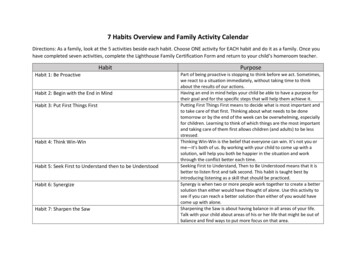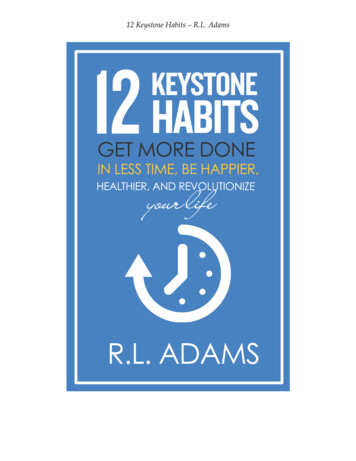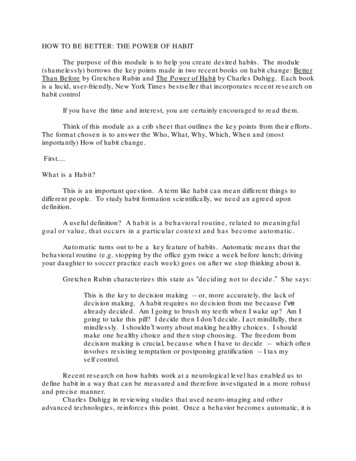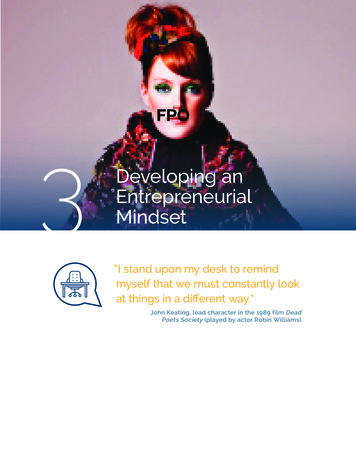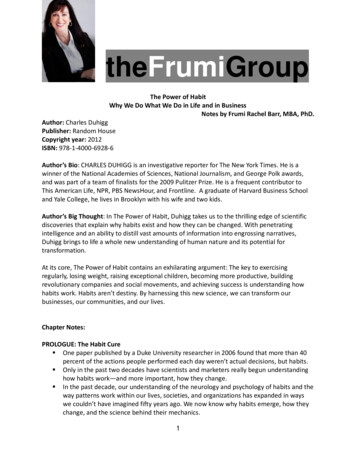
Transcription
theFrumiGroupThe Power of HabitWhy We Do What We Do in Life and in BusinessNotes by Frumi Rachel Barr, MBA, PhD.Author: Charles DuhiggPublisher: Random HouseCopyright year: 2012ISBN: 978-1-4000-6928-6Author’s Bio: CHARLES DUHIGG is an investigative reporter for The New York Times. He is awinner of the National Academies of Sciences, National Journalism, and George Polk awards,and was part of a team of finalists for the 2009 Pulitzer Prize. He is a frequent contributor toThis American Life, NPR, PBS NewsHour, and Frontline. A graduate of Harvard Business Schooland Yale College, he lives in Brooklyn with his wife and two kids.Author’s Big Thought: In The Power of Habit, Duhigg takes us to the thrilling edge of scientificdiscoveries that explain why habits exist and how they can be changed. With penetratingintelligence and an ability to distill vast amounts of information into engrossing narratives,Duhigg brings to life a whole new understanding of human nature and its potential fortransformation.At its core, The Power of Habit contains an exhilarating argument: The key to exercisingregularly, losing weight, raising exceptional children, becoming more productive, buildingrevolutionary companies and social movements, and achieving success is understanding howhabits work. Habits aren’t destiny. By harnessing this new science, we can transform ourbusinesses, our communities, and our lives.Chapter Notes:PROLOGUE: The Habit Cure One paper published by a Duke University researcher in 2006 found that more than 40percent of the actions people performed each day weren’t actual decisions, but habits. Only in the past two decades have scientists and marketers really begun understandinghow habits work—and more important, how they change. In the past decade, our understanding of the neurology and psychology of habits and theway patterns work within our lives, societies, and organizations has expanded in wayswe couldn’t have imagined fifty years ago. We now know why habits emerge, how theychange, and the science behind their mechanics.1
We know how to break them into parts and rebuild them to our specifications.We understand how to make people eat less, exercise more, work more efficiently, andlive healthier lives. Transforming a habit isn’t necessarily easy or quick. It isn’t alwayssimple. But it is possible. And now we understand how.PART ONE: The Habits of IndividualsChapter 1: THE HABIT LOOP - How Habits Work The process in which the brain converts a sequence of actions into an automatic routineis known as “chunking,” and it’s at the root of how habits form. There are dozens—if not hundreds—of behavioral chunks that we rely on every day.Some are simple: You automatically put toothpaste on your toothbrush before sticking itin your mouth. Some, such as getting dressed or making the kids’ lunch, are a little morecomplex. This process within our brains is a three-step loop. First, there is a cue, a trigger that tellsyour brain to go into automatic mode and which habit to use. Then there is the routine,which can be physical or mental or emotional. Finally, there is a reward, which helpsyour brain figure out if this particular loop is worth remembering for the future. Over time, this loop—cue, routine, reward; cue, routine, reward—becomes more andmore automatic. The cue and reward become intertwined until a powerful sense ofanticipation and craving emerges. Simply understanding how habits work—learning the structure of the habit loop—makesthem easier to control. Once you break a habit into its components, you can fiddle withthe gears. As long as your basal ganglia is intact and the cues remain constant, the behaviors willoccur unthinkingly. At the same time, however, the brain’s dependence on automaticroutines can be dangerous. Habits are often as much a curse as a benefit. Eugene was a case studied by Squire. A viral infection destroyed memory centers in hisbrain . Since Squire’s first paper on Eugene’s habits was published, the science of habitformation has exploded into a major field of study. Researchers at Duke, Harvard, UCLA,Yale, USC, Princeton, the University of Pennsylvania, and at schools in the UnitedKingdom, Germany, and the Netherlands, as well as corporate scientists working forProcter & Gamble, Microsoft, Google, and hundreds of other companies are focused onunderstanding the neurology and psychology of habits, their strengths and weaknesses,and why they emerge and how they can be changed. Researchers have learned that cues can be almost anything. Routines can be incrediblycomplex or fantastically simple and in almost every experiment, researchers have seenechoes of Squire’s discoveries with Eugene. Habits are powerful, but delicate. They can emerge outside our consciousness, or can bedeliberately designed. They often occur without our permission, but can be reshaped byfiddling with their parts.2
Chapter 2: THE CRAVING BRAIN - How to Create New Habits One day in the early 1900s, a prominent American executive named Claude C. Hopkinswas approached by an old friend with a new business idea. The friend had discovered anamazing product, he explained, that he was convinced would be a hit. It was atoothpaste, a minty, frothy concoction he called “Pepsodent.” Claude Hopkins was best known for a series of rules he coined explaining how to createnew habits among consumers. These rules would transform industries and eventuallybecame conventional wisdom among marketers, educational reformers, public healthprofessionals, politicians, and CEOs. Even today, Hopkins’s rules influence everything from how we buy cleaning supplies tothe tools governments use for eradicating disease. They are fundamental to creating anynew routine. “I finally agreed to undertake the campaign if he gave me a six months’ option on a blockof stock,” Hopkins wrote. It would be the wisest financial decision of Hopkins’s life. Thesecret to his success, Hopkins would later boast, was that he had found a certain kind ofcue and reward that fueled a particular habit. He created a craving. And that craving, itturns out, is what makes cues and rewards work. That craving is what powers the habitloop. The key, he said, was that he had “learned the right human psychology.” That psychologywas grounded in two basic rules:o First, find a simple and obvious cue.o Second, clearly define the rewards. If you get those elements right, Hopkins promised, it was like magic. Look at Pepsodent:He had identified a cue—tooth film—and reward—beautiful teeth—that had persuadedmillions to start a daily ritual. Even today, Hopkins’s rules are a staple of marketingtextbooks and the foundation of millions of ad campaigns. And those same principleshave been used to create thousands of other habits. Research on dieting says creating new food habits requires a predetermined cue—suchas planning menus in advance—and simple rewards for dieters when they stick to theirintentions. It turns out that Hopkins’s two rules aren’t enough. There’s also a third rule that must besatisfied to create a habit—a rule so subtle that Hopkins himself relied on it withoutknowing it existed. Habits are so powerful because they create neurological cravings. Most of the time,these cravings emerge so gradually that we’re not really aware they exist, so we’re oftenblind to their influence. But as we associate cues with certain rewards, a subconsciouscraving emerges in our brains that starts the habit loop spinning. This is how new habits are created: by putting together a cue, a routine, and a reward,and then cultivating a craving that drives the loop. Take email. When a computer chimesor a smartphone vibrates with a new message, the brain starts anticipating themomentary distraction that opening an email provides. That expectation, if unsatisfied,can build until a meeting is filled with antsy executives checking their buzzingBlackBerrys under the table, even if they know it’s probably only their latest fantasy3
football results. On the other hand, if someone disables the buzzing—and, thus,removes the cue—people can work for hours without thinking to check their in-boxes.Anyone can use this basic formula to create habits of her or his own. Want to exercisemore? Choose a cue, such as going to the gym as soon as you wake up, and a reward,such as a smoothie after each workout. Then think about that smoothie, or about theendorphin rush you’ll feel. Allow yourself to anticipate the reward. Eventually, thatcraving will make it easier to push through the gym doors every day.For companies, understanding the science of cravings is revolutionary. Cravings are whatdrive habits. And figuring out how to spark a craving makes creating a new habit easier.It’s as true now as it was almost a century ago. Every night, millions of people scrub theirteeth in order to get a tingling feeling; every morning, millions put on their jogging shoesto capture an endorphin rush they’ve learned to crave.Chapter 3: THE GOLDEN RULE OF HABIT CHANGE - Why Transformation Occurs You can never truly extinguish bad habits. Rather, to change a habit, you must keep theold cue, and deliver the old reward, but insert a new routine. That’s the rule: If you use the same cue, and provide the same reward, you can shift theroutine and change the habit. Almost any behavior can be transformed if the cue andreward stay the same. AA provides a method for attacking the habits that surround alcohol use. AA, in essence,is a giant machine for changing habit loops. And though the habits associated withalcoholism are extreme, the lessons AA provides demonstrate how almost any habit—even the most obstinate—can be changed. How do habits change? There is, unfortunately, no specific set of steps guaranteed towork for every person. We know that a habit cannot be eradicated—it must, instead, bereplaced. And we know that habits are most malleable when the Golden Rule of habitchange is applied: If we keep the same cue and the same reward, a new routine can beinserted. But that’s not enough. For a habit to stay changed, people must believe change ispossible. And most often, that belief only emerges with the help of a group. If you want to quit smoking, figure out a different routine that will satisfy the cravingsfilled by cigarettes. Then, find a support group, a collection of other former smokers, or acommunity that will help you believe you can stay away from nicotine, and use thatgroup when you feel you might stumble. If you want to lose weight, study your habits to determine why you really leave yourdesk for a snack each day, and then find someone else to take a walk with you, to gossipwith at their desk rather than in the cafeteria, a group that tracks weight-loss goalstogether, or someone who also wants to keep a stock of apples, rather than hips, nearby. The evidence is clear: If you want to change a habit, you must find an alternativeroutine, and your odds of success go up dramatically when you commit to changing aspart of a group. Belief is essential, and it grows out of a communal experience, even ifthat community is only as large as two people. It’s not just individual lives that can shift when habits are tended to. It’s also companies,organizations, and communities.4
PART TWO: The Habits of Successful OrganizationsChapter 4: KEYSTONE HABITS - Which Habits Matter Most Some habits matter more than others in remaking businesses and lives. These are“keystone habits” and they can influence how people work, eat, play, live, spend, andcommunicate. Keystone habits start a process that over time, transforms everything. Keystone habits say that success doesn’t depend on getting every single thing right, butinstead identifying a few key priorities and fashioning them into powerful levers. If you focus on changing or cultivating keystone habits, you can cause widespread shifts.However, identifying keystone habits is tricky. To find them, you have to know where tolook. This chapter has a wonderful story about how Paul O’Neill transformed Alcoa byfocusing on safety as a keystone habit. It’s worth the price of this book to buy it for thatalone. Keystone habits offer small wins – they help other habits to flourish by creating newstructures. And they establish cultures where change becomes contagious. Small wins are exactly what they sound like, and are part of how keystone habits createwidespread changes. A huge body of research has shown that small wins have enormouspower, an influence disproportionate to the accomplishments of the victoriesthemselves. Small wins fuel transformative changes by leveraging tiny advances into patterns thatconvince people that bigger achievements are within reach. The second way that keystone habits encourage change is: by creating structures thathelp other habits to flourish. O’Neill’s keystone habit—worker safety—had created a platform that encouragedanother practice—email—years ahead of competitors. The final way that keystone habits encourage widespread change: by creating cultureswhere new values become ingrained. Keystone habits make tough choices—such asfiring a top executive—easier, because when that person violates the culture, it’s clearthey lave to go. Cultures grow out of the keystone habits in every organization. Whether leaders areaware of them or not.Chapter 5: 5TARBUCKS AND THE HABIT OF SUCCESS - When Willpower Becomes Automatic Starbucks—like a handful of other companies—has succeeded in teaching the kind of lifeskills that schools, families, and communities have failed to provide. With more than 137,000 current employees and more than one million alumni,Starbucks is now, in a sense, one of the nation’s largest educators. All of thoseemployees, in their first year alone, spent at least fifty hours in Starbucks classrooms,and dozens more at home with Starbucks’ workbooks and talking to the Starbucksmentors assigned to them.5
At the core of that education is an intense focus on an all-important ability: willpower.Students who exerted high levels of willpower were more likely to earn higher grades intheir classes and gain admission into more selective schools. They had fewer absencesand spent less time watching television and more hours on homework.The best way to strengthen willpower and give students a leg up, studies indicate, is tomake it into a habit. As research on willpower has become a hot topic in scientificjournals and newspaper articles, it has started to trickle into corporate America.The solution, Starbucks discovered, was turning self-discipline into an organizationalhabit.When Starbucks’s attempts at boosting workers’ willpower through gym membershipsand diet workshops faltered, executives decided they needed to take a new approach.They started by looking more closely at what was actually happening inside their stores.They saw that their workers were failing when they came up against inflection points.What they needed were institutional habits that made it easier to muster their selfdiscipline.What employees really needed were clear instructions about how to deal with inflectionpoints—a routine for employees to follow when their willpower muscles went limp. Sothe company developed new training materials that spelled out routines for employeesto use when they hit rough patches. The manuals taught workers how to respond tospecific cues, such as a screaming customer or a long line at a cash register.Starbucks taught their employees how to handle moments of adversity by giving themwillpower habit loops.Today, the company is focused on giving employees a greater sense of authority. Theyhave asked workers to redesign how espresso machines and cash registers are laid out,to decide for themselves how customers should be greeted and where merchandiseshould be displayed. “People want to be in control of their lives.” Turnover has gonedown. Customer satisfaction is up.Chapter 6: THE POWER OF A CRISIS - How Leaders Create Habits Through Accident and Design Just as choosing the right keystone habits can create amazing change, the wrong onescan create disasters. Destructive organizational habits can be found within hundreds of industries and atthousands of firms. And almost always, they are the products of thoughtlessness, ofleaders who avoid thinking about the culture and so let it develop without guidance.There are no organizations without institutional habits. There are only places where theyare deliberately designed, and places where they are created without forethought, sothey often grow from rivalries or fear. But sometimes, even destructive habits can be transformed by leaders who know howto seize the right opportunities. Sometimes, in the heat of a crisis, the right habitsemerge. It may seem like most organizations make rational choices based on deliberate decisionmaking, but that’s not really how companies operate at all. Instead, firms are guided bylong-held organizational habits, patterns that often emerge from thousands ofemployees’ independent decisions. And these habits have profound impacts.6
These organizational habits—or “routines,” are enormously important, because withoutthem, most companies would never get any work done. Routines provide the hundredsof unwritten rules that companies need to operate. They allow workers to experimentwith new ideas without having to ask for permission at every step. They provide a kindof “organizational memory,” so that managers don’t have to reinvent the sales processevery six months or panic each time a VP quits. Routines reduce uncertainty.Among the most important benefits of routines is that they create truces betweenpotentially warring groups or individuals within an organization.Companies aren’t big happy families where everyone plays together nicely. Rather, mostworkplaces are made up of fiefdoms where executives compete for power and credit,often in hidden skirmishes that make their own performances appear superior and theirrivals’ seem worse. Divisions compete for resources and sabotage each other to stealglory.Companies aren’t families. They’re battlefields in a civil war.Organizational habits offer a basic promise: If you follow the established patterns andabide by the truce, then rivalries won’t destroy the company, the profits will roll in, and,eventually, everyone will getMost of the time, routines and truces work perfectly. Rivalries still exist, of course, butbecause of institutional habits, they’re kept within bounds and the business thrives.However, sometimes even a truce proves insufficient. Sometimes, an unstable peace canbe as destructive as any civil war.Creating successful organizations isn’t just a matter of balancing authority. For anorganization to work, leaders must cultivate habits that both create a real and balancedpeace and, paradoxically, make it absolutely clear who’s in charge.Sometimes, one priority—or one department or one person le goal—needs toovershadow everything else, though it might be unpopular or threaten the balance ofpower.There’s a paradox in this observation, of course. How can an organization implementhabits that balance authority and, at the same time, choose a person or goal that risesabove everyone else?The answer lies in seizing the same advantage—the possibilities created by a crisis.During turmoil, organizational habits become malleable enough to both assignresponsibility and create a more equitable balance of power. Crises are so valuable, infact that sometimes it’s worth stirring up a sense of looming catastrophe rather thanletting it die down.In fact, crises are such valuable opportunities that a wise leader often prolongs a senseof emergency on purpose.The same kinds of shifts are possible at any company where institutional habits—through thoughtlessness or neglect—have created toxic truces. A company withdysfunctional habits can’t turn around simply because a leader orders it. Rather, wiseexecutives seek out moments of crisis—or create the perception of crisis—and cultivatethe sense that something must change, until everyone is finally ready to overhaul thepatterns they live within each day.7
Chapter 7: HOW TARGET KNOWS WHAT YOU WANT BEFORE YOU DO - When CompaniesPredict (and Manipulate) Habits As little as twenty years ago retailers didn’t do intensely data-driven analysis. In the past two decades, however, as the retail marketplace has become more and morecompetitive, chains such as Target began to understand they couldn’t rely on the sameold bag of tricks. The only way to increase profits was to figure out each individualshopper’s habits and to market to people one by one, with personalized pitchesdesigned to appeal to customers’ unique buying preferences. In part, this realization came from a growing awareness of how powerfully habitsinfluence almost every shopping decision. Despite those lists, more than 50 percent of purchasing decisions occurred at themoment a customer saw a product on the shelf, because, despite shoppers’ bestintentions, their habits were stronger than their written intentions. The surprising aspect of these studies, however, was that even though everyone reliedon habits to guide their purchases, each person’s habits were different. Whether selling a new song, a new food, or a new crib, the lesson is the same: If youdress a new something in old habits, it’s easier for the public to accept it. When surveys were analyzed, it turned out that while a facility’s attractiveness and theavailability of workout machines might have caused people to join in the first place,what got them to stay was something else. Retention, the data said, was driven byemotional factors, such as whether employees knew members’ names or said hellowhen they walked in. People, it turns out, often go to the gym looking for a humanconnection, not a treadmill. It’s a variation of the lesson learned by Target and radio DJs: to sell a new habit—in thisease exercise—wrap it in something that people already know and like, such as theinstinct to go places where it’s easy to make friends. To market a new habit—be it groceries or aerobics—you must understand how to makethe novel seem familiar.PART THREE: The Habits of SocietiesChapter 8: THE MONTGOMERY BUS BOYCOTT - How Movements Happen On Thursday, December 1, 1955, in Montgomery, Alabama, Rosa Parks boarded a busand sat in a center row, right behind the white section, where either race could claim aseat. When asked to move, she refused and a movement made great leaps. What made this act more profound than many before it? A movement starts because ofthe social habits of friendship and the strong ties between close acquaintances. It growsbecause of the habits of a community, and the weak ties that hold neighborhoods andclans together. And it endures because a movement’s leaders give participants new habits that create afresh sense of identity and a feeling of ownership. But understanding how social habits work helps explain why Montgomery and RosaParks became the catalyst for a civil rights crusade.8
When Parks was arrested, it sparked something unusual within the city. Rosa Parks,unlike other people who had been jailed for violating the bus segregation law, wasdeeply respected and embedded within her community. So when she was arrested, ittriggered a series of social habits—the habits of friendship—that ignited an initialprotest.Parks’ membership in dozens of social networks across Montgomery allowed her friendsto muster a response before the community’s normal apathy could take hold.The Montgomery bus boycott became a society-wide action because the sense ofobligation that held the black community together was activated soon after Parks’friends started spreading the word. People who hardly knew Rosa Parks decided toparticipate because of a social peer pressure—an influence known as “the power ofweak ties”—that made it difficult to avoid joining in.There are, of course, numerous and complex reasons why the Montgomery bus boycottsucceeded and why it became the spark for a movement that would spread across theSouth. But one critical factor is this third aspect of social habits. Embedded withinMartin Luther King’s philosophy was a set of new behaviors that converted participantsfrom followers into self-directing leaders. These are not habits as we conventionallythink about them. However, when King recast Montgomery’s struggle by givingprotesters a new sense of self-identity, the protest became a movement fueled bypeople who were acting because they had taken ownership of a historic event. And thatsocial pattern, over time, became automatic and expanded to other places and groupsof students and protesters whom King never met but who could take on leadership ofthe movement simply by watching how its participants habitually behaved.On June 5, 1956, a panel of federal judges ruled that Montgomery’s bus segregation lawviolated the Constitution.Movements don’t emerge because everyone suddenly decides to face the samedirection at once. They rely on social patterns that begin as the habits of friendship,grow through the habits of communities, and are sustained by new habits that changeparticipants’ sense of self.Chapter 9: THE NEUROLOGY OF FREE WILL - Are We Responsible for Our Habits? Habits are not as simple as they appear. We can choose our habits, once we know how.Everything we know about habits, from neurologists studying amnesiacs andorganizational experts remaking companies, is that any of them can be changed, if youunderstand how they function. Every habit, no matter its complexity, is malleable. However, to modify a habit, you mustdecide to change it. You must consciously accept the hard work of identifying the cuesand rewards that drive the habits’ routines, and find alternatives. You must know youhave control and be self-conscious enough to use it. Once you know a habit exists, you have the responsibility to change it. Most all the other patterns that exist in most people’s lives—how we eat and sleep andtalk to our kids, how we unthinkingly spend our time, attention, and money—those arehabits that we know exist. And once you understand that habits can change, you havethe freedom—and the responsibility—to remake them. Once you understand that habits9
can be rebuilt, the power of habit becomes easier to grasp, and the only option left is toget to work.If you believe you can change—if you make it a habit—the change becomes real. This isthe real power of habit: the insight that your habits are what you choose them to be.Once that choice occurs—and becomes automatic—it’s not only real, it starts to seeminevitable.Recommendation: This book was not only full of enlightening information, it was also a greatread with many interesting stories.For more summaries like this, go to www.100MustReads.comContact Dr. Frumi at omwww.100mustreads.comwww.thewhyinstitute.comAbout the reviewer: Frumi Rachel Barr, MBA, PhDFrumi has a passion for inspiring leaders to look to the future, take decisive action and maintainmomentum to build profitable and sustainable companies. In a customized immersion format Frumiaccelerates the creation of strategic initiatives and an action plan to implement them. She is the TrustedAdvisor to call for facilitation needs.Frumi is inspired by two colleagues – Simon Sinek, author of Start With Why and John Streleckyauthor of The Why Café. She can guide you to align your company’s “Why” with that of yourcompany leaders and employees so that everyone understands the clarity of WHY you do whatyou do, the discipline of HOW you do what you do and the consistency of WHAT you do.Dr. Frumi is the author of A CEO’s Secret Weapon: How to Accelerate Success available onAmazon in both Kindle and paperback formats.To schedule a free Continuing with WHY consultation email DrFrumi@TheWhyInstitute.com orcall 949-729-1577.10
live healthier lives. Transforming a habit isn't necessarily easy or quick. It isn't always simple. But it is possible. And now we understand how. PART ONE: The Habits of Individuals Chapter 1: THE HABIT LOOP - How Habits Work The process in which the brain converts a sequence of actions into an automatic routine





